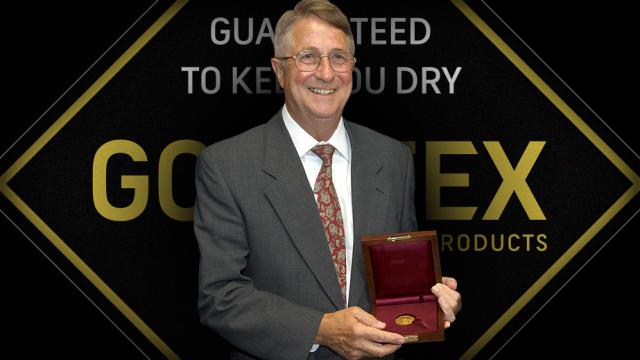His full name isn’t as well known as Thomas Edison or Alexander Graham Bell’s, but if you spend any amount of time outdoors, there’s a good chance you’ll find at least part of Robert W. Gore’s name on your gear. He’s the inventor of Gore-Tex, and at the age of 83, the celebrated inventor, engineer, and chemist passed away late last week.
Born in Salt Lake City, Utah, in 1937, Bob Gore seemed predestined to spend his life and career in the sciences as in 1950 his father moved their family to Newark, Delaware, to be closer to his work at DuPont’s largest research and development facility in Wilmington, Delaware. In 1959 Gore graduated from the University fo Delaware in 1959 with a bachelor’s degree in chemical engineering, and later earned his Master of Science and then a Ph.D. in chemical engineering from the University of Minnesota in 1963.
Before he was even out of college, however, Gore helped his father develop an insulated wire known as Multi-Tet cable by sandwiching multiple copper wires between layers of polytetrafluoroethylene (also known as PTFE, or the brand name Teflon) tape and bonding them together using heat. The product was a game-changer in fields like computing and communications equipment, with companies like IBM using the Muti-Tet ribbon cable in giant mainframe machines, and even NASA using it as part of the historic Apollo 11 mission.
The success of Multi-Tet allowed Gore’s parents to create W. L. Gore & Associates in 1958, a company that ran out of their family home for the first two years, with Gore himself being elected to its board of directors in 1961 while still a college student, and eventually being named its technical and research leader in 1967 after earning his PhD. In 1969, like many well-known products, Gore-Tex was invented by accident. Gore was trying to develop a process for slowly stretching PTFE into a thin tape for sealing threaded pipes when, out of frustration, he quickly yanked on the heated material and discovered it stretched over 800% in size resulting in a foam-like structure permeated with microscopic pores.
Through further research, Gore developed techniques for stretching the material into thin filaments but also large two-dimensional membranes that exhibited not only extreme strength but also excellent breathability. By sandwiching the PTFE membrane with other materials to further improve its durability and strength, a waterproof laminate called expanded polytetrafluoroethylene (or ePTFE) was created and trademarked with the brand name Gore-Tex.
[referenced id=”883211″ url=”https://gizmodo.com.au/2015/06/rain-jackets-explained/” thumb=”https://gizmodo.com.au/wp-content/uploads/2015/06/16/iqsbqcpwnlllz7zto0po-300×169.jpg” title=”Rain Jackets, Explained” excerpt=”For an incredibly simple concept — keeping you dry — rain jackets have involved into awfully complicated products. Air flow rates, water pressure resistance, durable water repellent coatings, hard shells, soft shells… the list of technical terms goes on. Here’s what they all mean, and how you can use them…”]
Making waterproof garments and footwear is relatively easy. You can cut a bunch of holes in a garbage bag and wear it like a vest to effectively keep rain out during a downpour. The downside is that it prevents the flow of moisture in both directions, so while rain is being kept out, the moisture from sweat evaporating off your body is kept in, making you feel damp and uncomfortable, and prevent your body from properly regulating its own temperature. This is why Gore-Tex used in clothing designed for the outdoors was such a game-changer. Every square inch of ePTFE contains around nine-billion microscopic holes large enough for water vapour and body heat to pass through and escape but too small for moisture from rain or snow to permeate, meaning it was effective at keeping your dry while being comfortable to wear, even during strenuous activities.
In 1976, the first consumer product made with Gore-Tex was sold; a tent from a company called Early Winters, Ltd. who started selling Gore-Tex rain gear the following year. Today, Gore-Tex is a term that’s synonymous with waterproof clothing and shoes, thanks in part to the company’s decision to allow other manufacturers to licence the material back in 1989. The same year the first Gore-Tex sent was sold, Gore was named the president and CEO of his family’s company and remained in that role until 2000 when he stepped down to become a chairman until 2016.
In his later years, Gore received countless honours for his work including the Winthrop-Sears Medal in 2003, the Perkin Medal in 2005, and in 2006 he was inducted into the American National Inventors Hall of Fame. His inventions (for which he owned nine patents), particularly Gore-Tex, allowed Gore to pursue philanthropic ventures as well, including major donations made to his alma maters as well as the state of Delaware.
According to the Gore website, “Bob is survived by his wife Jane and a large family of children, grandchildren and great-grandchildren as well as four siblings (Susan Gore, Ginger Giovale, David Gore, Betty Snyder) and extended family.”
